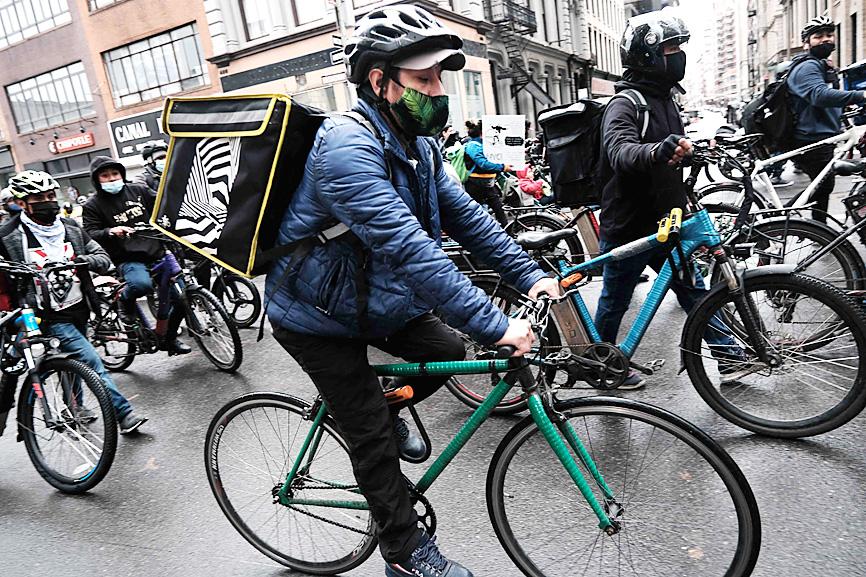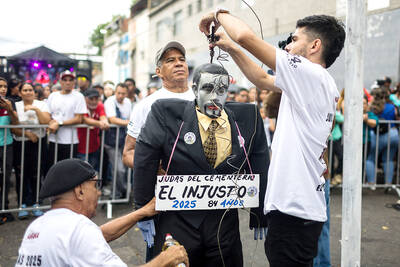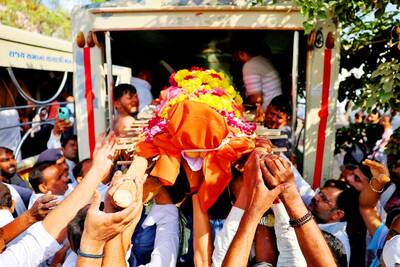New York City’s legions of food delivery workers — who were declared essential workers during the COVID-19 pandemic, but have no on the job access to bathrooms, health insurance or a minimum wage — are mobilizing for the first time to demand better working conditions.
The 80,000 “deliveristas,” overwhelmingly Hispanic immigrants who zip around the Big Apple on electric or other bikes come rain, snow or shine, are following the example of other “gig economy” workers such as Uber drivers in the UK who won the right to unionize in May after being recognized as “salaried workers,” in a world first.
In just a few months, Los Deliveristas Unidos, the first movement of independent riders for food delivery apps, has gained more than 1,000 members and more than 13,000 Facebook followers and set up numerous WhatsApp chats across New York.

Photo: AFP
The group has held large protests outside New York City Hall and, with the help of the Worker’s Justice Project and several councilors, managed to get the municipal legislature to debate six bills that would improve their conditions.
“We demand improvements. Life on the street is hard. One is exposed to insecurity, accidents, robberies, injustices, discrimination,” Gustavo Ajche, a 38-year-old Guatemalan deliveryman and group cofounder said at a recent demonstration.
Another Los Deliveristas Unidos leader, Jonan Mancilla, said the delivery workers want to earn the state minimum wage of US$15 an hour.
“We want to be respected,” the 33-year-old from Mexico said.
Several riders said most of the mobile app companies they work for — including Grubhub, Doordash, Seamless, Uber Eats, Instacart, PostMates and Caviar — do not pay them by the hour, but by delivery. They get between US$1 and US$4 for each delivery plus tips. Only Relay pays US$10 an hour.
The delivery workers say that sometimes apps or restaurants keep part of the tips and that they have to travel long distances for just a couple of dollars.
They also complain that companies do not help them if they are injured and that they do not cover expenses for their bike or the insulated bag they use to transport food.
“Sometimes restaurants don’t let us in the bathroom and we have to start looking for somewhere. That makes us lose a lot of time and deliveries,” said Orquidea Paz, a 27-year-old delivery worker and mother-of-four from Mexico.
Her husband, also a “deliverista,” said he works 15 hours a day, seven days a week.
“I don’t rest because I have a family to feed,” 32-year-old Aristeo Policao said.
The workers also say their bikes sometimes get stolen.
Recently, 200 of them registered their bicycles with police, while the Worker’s Justice Project provided many of them with GPS devices that help locate the vehicles.
The riders want the city to do more to combat the theft of electric bikes, which cost about US$1,850 — a fortune for immigrants who typically do not have papers or speak English.
“These workers face extreme abuse,” Worker’s Justice Project executive director Ligia Guallpa said. “Food delivery was one of the most essential jobs in the pandemic, but it is also the one with the fewest protections.”
“Even working 12 hours a day, seven days a week it is impossible to cover daily expenses to survive,” and “applications do not want to be held responsible,” he added.
A spokesperson for Grubhub said it does not take a cut of tips, but was unable to confirm how many riders it employs and their average salary.
“The health, safety and success of delivery workers across NYC is our top priority and critical to our business. We are overall supportive of the Los Deliveristas Unidos proposals, or already do what is proposed,” the spokesperson said.
A Doordash spokesperson said that it pays delivery workers 100 percent of their tips, that it has met riders several times to hear their complaints and that it is working “to improve working conditions.”
Other apps, including Seamless and Uber Eats, did not respond to requests for comment.

POLITICAL PRISONERS VS DEPORTEES: Venezuela’s prosecutor’s office slammed the call by El Salvador’s leader, accusing him of crimes against humanity Salvadoran President Nayib Bukele on Sunday proposed carrying out a prisoner swap with Venezuela, suggesting he would exchange Venezuelan deportees from the US his government has kept imprisoned for what he called “political prisoners” in Venezuela. In a post on X, directed at Venezuelan President Nicolas Maduro, Bukele listed off a number of family members of high-level opposition figures in Venezuela, journalists and activists detained during the South American government’s electoral crackdown last year. “The only reason they are imprisoned is for having opposed you and your electoral fraud,” he wrote to Maduro. “However, I want to propose a humanitarian agreement that

ECONOMIC WORRIES: The ruling PAP faces voters amid concerns that the city-state faces the possibility of a recession and job losses amid Washington’s tariffs Singapore yesterday finalized contestants for its general election on Saturday next week, with the ruling People’s Action Party (PAP) fielding 32 new candidates in the biggest refresh of the party that has ruled the city-state since independence in 1965. The move follows a pledge by Singaporean Prime Minister Lawrence Wong (黃循財), who took office last year and assumed the PAP leadership, to “bring in new blood, new ideas and new energy” to steer the country of 6 million people. His latest shake-up beats that of predecessors Lee Hsien Loong (李顯龍) and Goh Chok Tong (吳作棟), who replaced 24 and 11 politicians respectively

Young women standing idly around a park in Tokyo’s west suggest that a giant statue of Godzilla is not the only attraction for a record number of foreign tourists. Their faces lit by the cold glow of their phones, the women lining Okubo Park are evidence that sex tourism has developed as a dark flipside to the bustling Kabukicho nightlife district. Increasing numbers of foreign men are flocking to the area after seeing videos on social media. One of the women said that the area near Kabukicho, where Godzilla rumbles and belches smoke atop a cinema, has become a “real

‘WATER WARFARE’: A Pakistani official called India’s suspension of a 65-year-old treaty on the sharing of waters from the Indus River ‘a cowardly, illegal move’ Pakistan yesterday canceled visas for Indian nationals, closed its airspace for all Indian-owned or operated airlines, and suspended all trade with India, including to and from any third country. The retaliatory measures follow India’s decision to suspend visas for Pakistani nationals in the aftermath of a deadly attack by shooters in Kashmir that killed 26 people, mostly tourists. The rare attack on civilians shocked and outraged India and prompted calls for action against their country’s archenemy, Pakistan. New Delhi did not publicly produce evidence connecting the attack to its neighbor, but said it had “cross-border” links to Pakistan. Pakistan denied any connection to